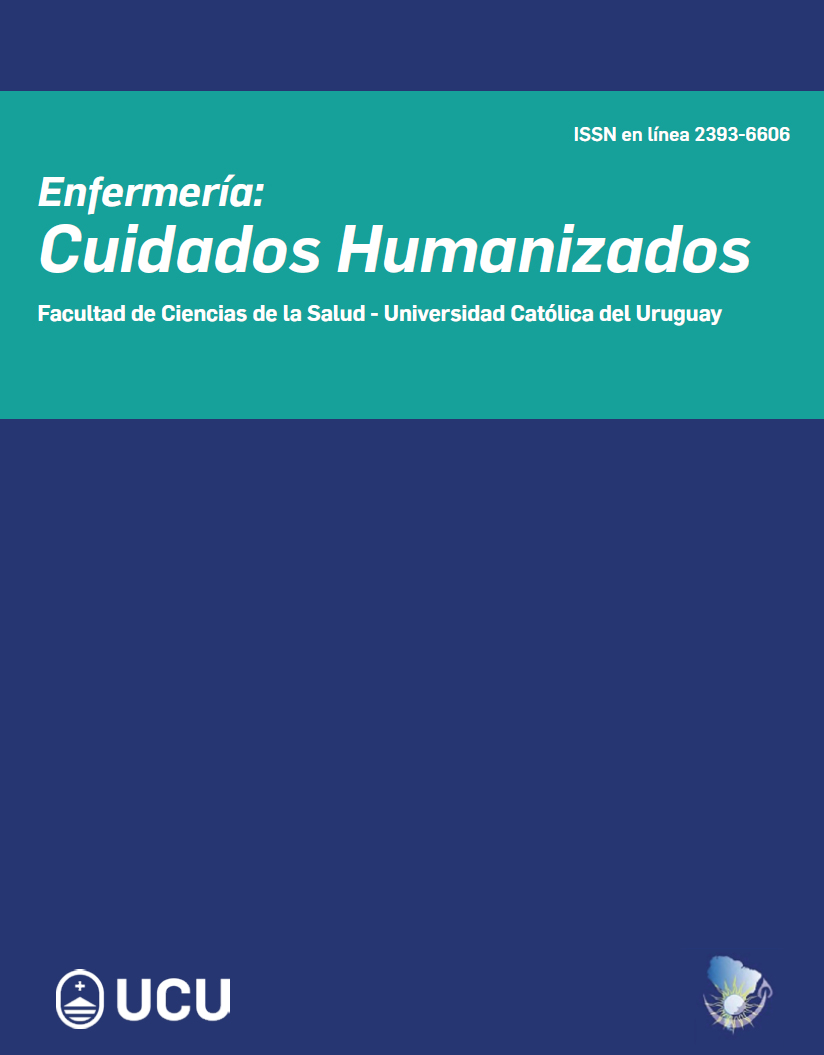Abortion from the Perspective of Undergraduate Nursing Students
DOI:
https://doi.org/10.22235/ech.v13i1.3668Keywords:
nursing students, nursing care, induced abortion, social representationAbstract
Objectives: Exploring the social representations of nursing students about induced abortion and discuss the social representations of nursing care for women undergoing an abortion or post-abortion with complications. Method: This is a qualitative study based on the Theory of Social Representations, carried out with 16 nursing students from the Nursing course in the Northeast region of Brazil held in November 2022. The inclusion criterion was being a student of nursing duly enrolled in the 2022.2 semester at UNEB and exclusion must be under 18 years of age. Data were collected through semi-structured interviews and analyzed using the Iramuteq software, which generated the Descending Hierarchical Classification. Results: After processing the data and grouping the words carried out by the system, the text segments were classified and the names of the classes were defined: Class 1: Nursing care for women undergoing an abortion; Class 2: Representation of induced abortion from the perspective of sexual and reproductive rights and its legalization as a way of reducing the risk of complications and death; Class 3: Representation of induced abortion from the perspective of sexual and reproductive rights and its legalization as a way of reducing the risk of complications and death. Conclusion: It is necessary that during graduation the topic is discussed more frequently so that knowledge can be expanded in the face of the challenges and complexities that future professionals will deal with when providing care to women in the process of miscarriage or post-abortion with complications.
Downloads
References
Silva AR da, Franco APM, Sousa AC de, Souza MAAF de, Saraiva K de S, Pantoja GKC, et al. Diferentes visões sobre o abortamento provocado: uma revisão integrativa. Brazilian Journal of Development. 2021;7(6):59046-59067. doi: 10.34117/bjdv7n6-342
Polis CB, Mhango C, Philbin J, Chimwaza W, Chipeta E, Msusa A. Incidence of induced abortion in Malawi, 2015. PLoS ONE. 2017;12(4):e0173639. doi: 10.1371/journal.pone.0173639
Soares IC, Santos KA. Os sentidos da maternidade no discurso sobre aborto. Revista TEL. 2019;10(2):132-153. doi: 10.5935/2177-6644.20190023
Mendes RWM, Francisco AMC, Tostes CB da S, Reis J dos, Von Atzingen AC. Conscientious Objection to Legal Abortion in Minas Gerais State. Revista Brasileira de Ginecologia e Obstetrícia. 2020;42(11):746-51. doi: 10.1055/s-0040-1721683
Enyew MM. Willingness to perform induced abortion and associated factors among graduating midwifery, medical, nursing, and public health officer students of Universi-ty of Gondar, Northwest Ethiopia: institution based cross sectional study. BMC Pregnancy and Childbirth. 2020;46(1):25-34. doi: 10.1186/s12884-020-03382-0
Bento SF, Pádua KS de, Pacagnella R de C, Fernandes KG, Osis MJD, Duarte GA, et al. Advantages and Disadvantages of Medical Abortion, According to Brazilian Residents in Obstetrics and Gynaecology. Revista Brasileira de Ginecologia e Obstetrícia. 2020;42(12):793-799. doi: 10.1055/s-0040-1718952
Bento SF, Pádua KS, Faúndes A, Carvalho Pacagnella R, Fernandes KG, Osis MJD. Understanding of changes in abortion rate following liberalization of abortion law among Brazilian residents in obstetrics and gynecology. International Journal of Gynaecology and Obstetrics: The Official Organ of the International Federation of Gynaecology and Obstetrics. 2020;149(2):197-202. doi: 10.1002/ijgo.13123
Conselho Federal de Enfermagem [Internet]. Resolução COFEN n.º 564/2017. Available from: http://www.cofen.gov.br/resolucao-cofen-no-5642017_59145.html
Borges LCV, Clemente NR, Netto L. (In)Congruência na assistência às mulheres em situação de abortamento: o que dizem os acadêmicos sobre seus processos formativos. Reme Revista Mineira de Enfermagem. 2020;24:e1297. doi: 10.5935/1415-2762.20200026
Madeiro AP, Rufino AC. Maus-tratos e discriminação na assistência ao aborto provocado: a percepção das mulheres em Teresina, Piauí, Brasil. Ciência & Saúde Coletiva. 2017;22(8):2771-2780. doi: 10.1590/1413-81232017228.04252016.
Troche-Gutiérrez IY, Cerquera-Bonilla AC. Percepciones sobre interrupción voluntaria del embarazo en estudiantes de pregrado en enfermería. Revista Ciencia y Cuidado. 2021;18(1):9-19. doi: 10.22463/17949831.2466.
Banchs MA. Alternativas de apropriação teórica: abordagem processual e estrutural das representações sociais. REEDUC. 2004;1(2):39-60. Available from: https://mestradoedoutoradoestacio.periodicoscientificos.com.br/index.php/reeduc/article/view/2288
Souza VR dos S, Marziale MHP, Silva GTR, Nascimento PL. Tradução e validação para a língua portuguesa e avaliação do guia COREQ. Acta Paulista de Enfermagem. 2021;34:eAPE02631. doi: 10.37689/acta-ape/2021AO02631
Conselho Nacional de Saúde [Internet]. Resolução n.º 466/2012. Available from: https://conselho.saude.gov.br/resolucoes/2012/Reso466.pdf.
Batista EC, Matos LAL, Nascimento AB. A entrevista como técnica de investigação na pesquisa qualitativa. Revista Interdisciplinar Científica Aplicada. 2017;11(3):23-38. doi: 10.13140/RG.2.2.10084.09608
Falqueto JMZ, Hoffmann VE, Farias JS. Saturação Teórica em Pesquisas Qualitativas: Relato de uma Experiência de Aplicação em Estudo na Área de Administração. Revista de Ciências da Administração. 2019;1(3):40-53. doi: 10.5007/2175-8077.2018V20n52p40
Souza MAR de, Wall ML, Thuler AC de MC, Lowen IMV, Peres AM. O uso do software IRAMUTEQ na análise de dados em pesquisas qualitativas. Revista da Escola de Enfermagem da USP. 2018;52:e03353. doi: 10.1590/S1980-220X2017015003353
Brigido V, Camargo JA. Tutorial para uso do software de análise textual IRAMUTEQ [Internet]. 2013. Available from: http://www.iramuteq.org/documentation/fichiers/tutoriel-en-portugais
Pereira AL de F, Schoreter MS. Abordagem do tema do aborto no ensino de graduação na perspectiva das enfermeiras recém-graduadas. Rev. enferm. UERJ. 2019;27: e36835. doi: 10.12957/reuerj.2019.36835
Fontenele AL, Ferreira GI, Neves M da GC, Guilhem DB. Opiniões e conhecimentos de acadêmicos de enfermagem sobre o aborto previsto em lei: estudo descritivo. Revista Ciência, cuidado e sáude. 2019;18(1):e45112. Available from: https://periodicos.uem.br/ojs/index.php/CiencCuidSaude/article/view/45112
Silva LF, Ferreira CAL, Freitas EAO. A enfermagem frente ao aborto legal. Connection Line, Revista Eletrônica do UNIVAG [Internet]. 2019 [cited 2023 Aug 24];(21). doi: 10.18312/connectionline.v0i21.1401
Pitilin É de B, Banazeski AC, Bedin R, Gasparin VA. Cuidados de enfermería en situaciones de aborto inducido/provocado: una revisión integral de la literatura. Enfermería Global [Internet]. 2016 [cited 2023 Aug 24];15(43):439-451. Available from: https://scielo.isciii.es/scielo.php?script=sci_arttext&pid=S1695-61412016000300017&lng=es&nrm=iso&tlng=pt
Vedana BB, Gervasoni TA. Os movimentos feministas na América-Latina e as perspectivas para a efetivação dos direitos sexuais e reprodutivos das mulheres brasileiras. Revista Ártemis. 2020;29(1):279-298. doi: 10.22478/ufpb.1807-8214.2020v29n1.49848
Lima AP de, Lima T de. “Joga pedra na geni”: Um estudo sobre a cultura do estupro e sua relação com a negação dos direitos sexuais e reprodutivos das mulheres. Revista Eletrônica da Estácio Recife [Internet]. 2017 [cited 2023 Aug 24];3(2). Available from: https://reer.emnuvens.com.br/reer/article/view/149/50#
Agostinho A, Mapelli LD, Arantes BM, Gozzo T de O. Mulher em situação de abortamento: um olhar de uma equipe de enfermagem. Revista Eletrônica Acervo Saúde. 2022 24;15(9):e10790. doi: 10.25248/reas.e10790.2022.
Published
How to Cite
Issue
Section
License
Copyright (c) 2024 Enfermería: Cuidados Humanizados

This work is licensed under a Creative Commons Attribution 4.0 International License.

















